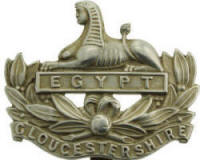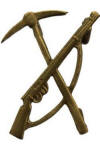|
Fallen Officers of the Great War | Gloucestershire Regiment |
Project Home Page Gloucestershire Regiment Officers Roll of Honour Contact Site Author/Webmaster
|
Roll of Honour of Officers of the Gloucestershire Regiment Who Died in the Great War |

Copyright and source: British Military Badges
|
Those Officers of The Gloucestershire Regiment Who Died in the Great War Whilst Serving With 13th (Service) Battalion (Forest of Dean)(Pioneers) |
|
No |
Date Died |
Surname |
Forenames |
Rank |
Decs |
Age |
Cause |
Country |
Location/Sector |
Cemetery/Memorial |
Notes |
|
Died in 1916 (3 officers) |
|||||||||||
|
1 |
30th June |
MILES |
Allan Oswald |
2Lt |
- |
27 |
KIA |
France |
"Boar's Head", southeast of Richebourg L'Avoue |
Loos Memorial (Panel 60 to 64) |
- |
|
2 |
3rd September |
BENNETT |
Reginald |
2Lt |
- |
27 |
KIA |
France |
Near St Pierre Divion, northeast of Thiepval |
Thiepval Memorial (Pier/Face 5A and 5B) |
- |
|
3 |
13th October |
DRAKE |
Percy Albert |
2Lt |
- |
26 |
KIA |
France |
Schwaben Redoubt, north of Thiepval |
Lonsdale Cemetery, Authuile (VII.A.4) |
- |
|
Died in 1917 (2 officers) |
|||||||||||
|
4 |
3rd July |
FRAMPTON |
John Reginald |
2Lt |
- |
21 |
KIA |
Belgium |
Near St Jean, north east of Ypres |
Vlamertinghe New Military Cemetery (IV.B.9) |
- |
|
5 |
31st July |
EATON |
Harold |
2Lt |
- |
30 |
KIA |
Belgium |
Near St Julien, north east of Ypres |
DuHallow ADS Cemetery, N of Ypres (I.A.35) |
- |
|
Died in 1918 (8 officers) |
|||||||||||
|
6 |
23rd March |
BURTON |
Charles Harold |
2Lt |
- |
22 |
KIA |
France |
Near Herbecourt, west of Peronne, Somme |
Pozieres Memorial (Panel 40 and 41) |
- |
|
7 |
30th March |
CALCUTT |
Albert Birch |
2Lt |
- |
23 |
KIA |
France |
Near Aubercourt, southeast of Villers-Bretonneux |
Pozieres Memorial (Panel 40 and 41) |
- |
|
8 |
30th March |
DANNE |
Arthur William Brian |
Lt |
- |
20 |
KIA |
France |
Near Aubercourt, southeast of Villers-Bretonneux |
Pozieres Memorial (Panel 40 and 41) |
- |
|
9 |
30th March |
HARVEY |
Henry Burnett |
2Lt |
- |
23 |
KIA |
France |
Near Aubercourt, southeast of Villers-Bretonneux |
Pozieres Memorial (Panel 40 and 41) |
- |
|
10 |
30th March |
HILLIER |
Geoffrey Stuart Drummond |
Capt |
MiD |
23 |
KIA |
France |
Near Aubercourt, southeast of Villers-Bretonneux |
Pozieres Memorial (Panel 40 and 41) |
- |
|
11 |
26th April |
HAGUE |
Leonard |
2Lt |
- |
32 |
KIA |
Belgium |
"The Bluff", west of Battle Wood, south east of Ypres |
Tyne Cot Memorial (Panel 72 to 75) |
- |
|
12 |
26th April |
HOMER |
William Howard Claude |
Lt |
MC |
31 |
KIA |
Belgium |
"The Bluff", west of Battle Wood, south east of Ypres |
Tyne Cot Memorial (Panel 72 to 75) |
- |
|
13 |
26th April |
HOWMAN |
Henry Roger |
Major |
MiD |
40 |
KIA |
Belgium |
"The Bluff", west of Battle Wood, south east of Ypres |
Perth Cemetery (China Wall) E of Ypres (I.G.25) |
- |
|
Battalion History |
|
The 13th Battalion was raised in December 1914 at
Malvern by Sir
Henry Webb MP and
recruited from the miners of the Forest of Dean, South Wales and
the Durham coalfields. In July 1915, the Battalion was taken over by
the War Office and was moved to Witley Camp, Surrey to continue
its intensive training for combat operations. In
August 1915 the Battalion was placed under command of 39th
Division as the Divisional Pioneer unit. .
On 3rd March 1916 the Battalion
departed Witley Camp and entrained for Southampton Docks.
It embarked on SS Marguerette and SS Maiden, arriving at Le Havre
on 4th March. After an overnight stay the Battalion
was moved by train to Thiennes, near Hazebrouck and marched to
camp at Steenbecque, arriving on 6th March under temporary
command of HQ III Corps. For the next two days the
Battalion was put to work repairing roads and other
infrastructure at the camp. On 9th March the
Battalion was temporarily split up, Companies going to La
Mottee, Sailly, Laventie and Estaires undertaking various pioneer
and engineering tasks in those areas. On 26th March
the Battalion concentrated near Bethune and Companies were
placed under command of various Divisional Field Companies RE,
assisting them in creating barbed-wire entanglements, saps,
communication trenches and
defensive works. On 14th April the Battalion
concentrated at Essars and was formally placed under command of
39th Division as Divisional Pioneers, working in the
Festubert-Givenchy-La Bassee Canal sectors.
The Battalion saw its first significant action on 30th June
1916, during the Battle
of the Boar's Head,
when it dug communication trenches behind the assaulting troops.
On several occasions during the battle the Pioneers had to stop
digging to defend themselves, and the Battalion suffered 71
casualties. It saw action again towards the end of 1916
during operations on the Ancre. In March 1918, the
Battalion suffered particularly badly in the opening week of the German
Spring Offensive,
during which it was required to take positions in the line as
infantry, and by the time the Division was withdrawn on
31st March the Battalion had sustained 326 casualties. On 10th
April 1918 at St Omer, 450 men and nine officers were allocated to
the newly formed 2nd Battalion
of the Divisional Composite Infantry Brigade, and nine
officers to No 1 Battalion of the Composite Brigade.
The Composite Brigade last saw action
on 26 April during the Second Battle of Kemmel, part of the
Battle of the Lys, after which, on 5th May 1918, all detached
officers and men rejoined the Battalion at Ruminghem, southeast
of Calais. The Battalion was then ordered to form training cadre on 10th May 1918
in the form of a Demonstration Company, with all other surplus
personnel being sent to Etaples for onward posting to other
Gloucestershire Regiment units. One of the main roles of
the demonstration Company was to train
the 105th Engineer Regiment of the AEF.
On 15th August 1918, the Battalion cadre was transferred to 197th
Brigade of the 66th (2nd East Lancashire) Division, in
preparation for major reinforcement and re-roling as an
infantry/pioneer battalion. The Battalion
remained with the Brigade when the Brigade was
transferred to Lines of Communication duties on 20th September
1918 in the Calais and Dieppe area under orders of HQ BEF.
On 18th December 1918 whilst at Le
Havre, under command of 116th Infantry Brigade, the first men,
miners and medically downgraded left the unit for demobilisation
which continued throughout January, February, March, April and
May 1919. On 3rd May 1919 the Battalion was placed
under command of 197th Brigade until later in the month when the
Battalion was disbanded.
The Battalion earned Battle Honours during the Great War:
France and Flanders 1915 - 1918, Ypres 1917, Somme
1916 and 1918, Ancre Heights, Ancre 1916,
Pilckem, St Quentin, Rosieres and Kemmel.
Copyright and source: The Long, Long Trail The brass “collar dog” insignia worn by men of Pioneer Battalions in the British Expeditionary Force. The design is of a crossed rifle and pick, representing the battalion's dual fighting and labouring role. |
|
Regimental History |
|
The Gloucestershire Regiment was formed on 1st July 1881 as part of the Childers Reforms which saw the amalgamation of the 28th (North Gloucestershire) Regiment of Foot and the 61st (South Gloucestershire) Regiment of Foot. These two units became respectively the regular 1st and 2nd Battalions of the Regiment, with the Regimental Depot based at Horfield Barracks, Bristol. The 1881 reforms also redesignated the Militia and Rifle Volunteer Corps (RVC) units within the Regimental District of Gloucestershire as Battalions of the Regiment - the Royal South Gloucestershire Militia forming the 3rd (Militia) Battalion and the Royal North Gloucestershire Militia forming the 4th Militia Battalion. The 1st (City of Bristol) Gloucestershire Rifle Volunteers formed the 1st (City of Bristol) Volunteer Battalion and the 2nd Gloucestershire Rifle Volunteers forming the 2nd Volunteer Battalion. In 1908, as part of the Haldane Reforms, the two Militia Battalions were reorganised and restructured forming the 3rd (Special Reserve) Battalion and the three Volunteer Battalions (the 3rd Volunteer Battalion had been formed in 1900) were reformed the 4th, 5th and 6th Battalions of the Regimental Territorial Force (TF). After the Declaration of War on 4th August 1914 and at various stages up to 1st July 1918, the Gloucestershire Regiment had formed, disbanded or re-constituted up to 27 Regular, Territorial Force, Service and Reserve Battalions. Detailed history of the Gloucestershire Regiment can be viewed here, here and here. |
Page last updated: 30th May 2025
| Project Home Page | Glos Regt Home Page | Glos Regt Officer Casualty Analysis | Commonwealth War Graves Commission | Glos Regt in the Great War |
| Regimental Roll of Honour | Surnames - A | Surnames - B | Surnames - C | Surnames - D | Surnames - E | Surnames - F | Surnames - G | Surnames - H |
| Surnames - I | Surnames - J | Surnames - K | Surnames - L | Surnames - M | Surnames - N | Surnames - O |
| Surnames - P | Surnames - Q | Surnames - R | Surnames - S | Surnames - T | Surnames - V | Surnames - W | Surnames - Y |
| Roll of Honour By Year | 1914 | 1915 | 1916 | 1917 | 1918 | 1919 to 1921 |
| Roll of Honour By Unit | 1st Battalion | 2nd Battalion | 3rd (Reserve) Battalion | 1/4th Battalion TF | 2/4th Battalion TF | 1/5th Battalion TF | 2/5th Battalion TF |
| 1/6th Battalion TF | 2/6th Battalion TF | 7th (Service) Battalion | 8th (Service) Battalion | 9th (Service) Battalion | 10th (Service) Battalion |
| 12th (Service) Battalion | 13th (Service) Battalion | 14th (Service) Battalion | Officers Detached From Glos Regt | Non-Active List of Officers | Officers Attached to Glos Regt |
